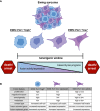The importance of fusion protein activity in Ewing sarcoma and the cell intrinsic and extrinsic factors that regulate it: A review
- PMID: 36505823
- PMCID: PMC9727305
- DOI: 10.3389/fonc.2022.1044707
The importance of fusion protein activity in Ewing sarcoma and the cell intrinsic and extrinsic factors that regulate it: A review
Abstract
Accumulating evidence shows that despite clonal origins tumors eventually become complex communities comprised of phenotypically distinct cell subpopulations. This heterogeneity arises from both tumor cell intrinsic programs and signals from spatially and temporally dynamic microenvironments. While pediatric cancers usually lack the mutational burden of adult cancers, they still exhibit high levels of cellular heterogeneity that are largely mediated by epigenetic mechanisms. Ewing sarcomas are aggressive bone and soft tissue malignancies with peak incidence in adolescence and the prognosis for patients with relapsed and metastatic disease is dismal. Ewing sarcomas are driven by a single pathognomonic fusion between a FET protein and an ETS family transcription factor, the most common of which is EWS::FLI1. Despite sharing a single driver mutation, Ewing sarcoma cells demonstrate a high degree of transcriptional heterogeneity both between and within tumors. Recent studies have identified differential fusion protein activity as a key source of this heterogeneity which leads to profoundly different cellular phenotypes. Paradoxically, increased invasive and metastatic potential is associated with lower EWS::FLI1 activity. Here, we review what is currently understood about EWS::FLI1 activity, the cell autonomous and tumor microenvironmental factors that regulate it, and the downstream consequences of these activity states on tumor progression. We specifically highlight how transcription factor regulation, signaling pathway modulation, and the extracellular matrix intersect to create a complex network of tumor cell phenotypes. We propose that elucidation of the mechanisms by which these essential elements interact will enable the development of novel therapeutic approaches that are designed to target this complexity and ultimately improve patient outcomes.
Keywords: Ewing sarcoma; cell phenotype; heterogeneity; oncogene; plasticity.
Copyright © 2022 Apfelbaum, Wrenn and Lawlor.
Conflict of interest statement
The authors declare that the research was conducted in the absence of any commercial or financial relationships that could be construed as a potential conflict of interest.
Figures



Similar articles
-
EWS/FLI1 Characterization, Activation, Repression, Target Genes and Therapeutic Opportunities in Ewing Sarcoma.Int J Mol Sci. 2023 Oct 14;24(20):15173. doi: 10.3390/ijms242015173. Int J Mol Sci. 2023. PMID: 37894854 Free PMC article. Review.
-
Activation of Wnt/β-Catenin in Ewing Sarcoma Cells Antagonizes EWS/ETS Function and Promotes Phenotypic Transition to More Metastatic Cell States.Cancer Res. 2016 Sep 1;76(17):5040-53. doi: 10.1158/0008-5472.CAN-15-3422. Epub 2016 Jun 30. Cancer Res. 2016. PMID: 27364557 Free PMC article.
-
A novel oncogenic mechanism in Ewing sarcoma involving IGF pathway targeting by EWS/Fli1-regulated microRNAs.Oncogene. 2011 Dec 8;30(49):4910-20. doi: 10.1038/onc.2011.197. Epub 2011 Jun 6. Oncogene. 2011. PMID: 21643012 Free PMC article.
-
Targeted inhibition of histone deacetylase leads to suppression of Ewing sarcoma tumor growth through an unappreciated EWS-FLI1/HDAC3/HSP90 signaling axis.J Mol Med (Berl). 2019 Jul;97(7):957-972. doi: 10.1007/s00109-019-01782-0. Epub 2019 Apr 25. J Mol Med (Berl). 2019. PMID: 31025088 Free PMC article.
-
Blocking the road, stopping the engine or killing the driver? Advances in targeting EWS/FLI-1 fusion in Ewing sarcoma as novel therapy.Expert Opin Ther Targets. 2014 Nov;18(11):1315-28. doi: 10.1517/14728222.2014.947963. Epub 2014 Aug 27. Expert Opin Ther Targets. 2014. PMID: 25162919 Review.
Cited by
-
Druggable upregulated proteins in EWS-FLI-driven Ewing sarcoma as emerging new therapeutic targets.Am J Transl Res. 2025 Mar 15;17(3):1580-1603. doi: 10.62347/YMEU1808. eCollection 2025. Am J Transl Res. 2025. PMID: 40225989 Free PMC article. Review.
-
ETS1, a target gene of the EWSR1::FLI1 fusion oncoprotein, regulates the expression of the focal adhesion protein TENSIN3.bioRxiv [Preprint]. 2023 Dec 23:2023.12.21.572864. doi: 10.1101/2023.12.21.572864. bioRxiv. 2023. Update in: Mol Cancer Res. 2024 Jul 2;22(7):625-641. doi: 10.1158/1541-7786.MCR-23-1090. PMID: 38187702 Free PMC article. Updated. Preprint.
-
The Role of Chronic Inflammation in Pediatric Cancer.Cancers (Basel). 2025 Jan 6;17(1):154. doi: 10.3390/cancers17010154. Cancers (Basel). 2025. PMID: 39796780 Free PMC article. Review.
-
Targeting metastasis in paediatric bone sarcomas.Mol Cancer. 2025 May 29;24(1):153. doi: 10.1186/s12943-025-02365-z. Mol Cancer. 2025. PMID: 40442778 Free PMC article. Review.
-
EWS-FLI1 and Activator Protein-1 (AP-1) Reciprocally Regulate Extracellular-Matrix Proteins in Ewing sarcoma Cells.Int J Mol Sci. 2024 Aug 6;25(16):8595. doi: 10.3390/ijms25168595. Int J Mol Sci. 2024. PMID: 39201282 Free PMC article.
References
-
- Hanahan D. Hallmarks of cancer: New dimensions. Cancer Discov (2022) 12(1):31–46. doi: 10.1158/2159-8290.cd-21-1059 - DOI - PubMed
Publication types
Grants and funding
LinkOut - more resources
Full Text Sources

